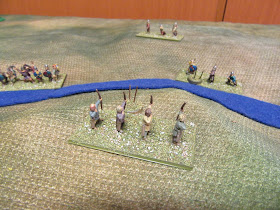The hypothesis on the yahoo group (advanced by Patrick Waterson) was that the hoplite system as represented in Lost Battles is actually tactically superior to the legionary system in the same.
It's just the kind of 'how many angels can fit on the head of a pin' wargaming argument that rings my bell, so I've been enjoying exploring it on the table.
I won't bore readers with details, but as hoplites can use depth to greater effect and legionaries have greater staying power, the answer, unsurprisingly, is that any such clash would depend on the terrain and the exact composition of the armies.
In the real world no such clash of systems occurred, but in my hypothetical battles the Greeks won three out of four despite having a lower fighting value. Veteran hoplites tended to chew through the legionaries very quickly, but where average quality hoplites were fighting average quality legionaries, the Roman cavalry generally had enough time to outflank the Greeks and gain the advantage.
It was another interesting Lost Battles experiment and, incidentally, the first chance I've had to field my Xyston hoplites.
 |
| 'Hoplites, Sah. A few dozen of 'em!' |
 |
| Diceless variant by Patrick Waterson - requiring lots of note-keeping and markers. |














